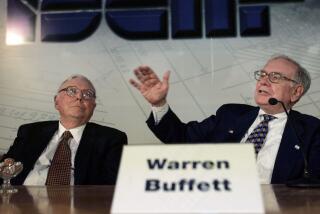Lessons in the Legacy of Charles Steadman
- Share via
Charles Walters Steadman, the Rembrandt of Red Ink, died last month, but his four woeful mutual funds hold to a path that will haunt investors until they (or the funds) are as legally dead as Steadman himself.
For years, Steadman was a mystery in the world of finance, fascinating for his doggedly continuing to run a company that managed funds with awful returns--funds that regularly graced the bottoms of all kinds of fund performance lists.
Some believed he was a bumbler, buffoon or the world’s unluckiest man. He was not. His passing should be noted because it reminds us of the lessons his funds teach.
To remember his legacy, let’s dig up the dirt and bury Steadman one last time.
Steadman’s “best” fund and only winner over the last 10 years, Steadman Associated, is up a total of 29%, compared with a gain of 10 times that by the Standard & Poor’s 500 index. His two worst funds, American Industry and the grossly misnamed Technology & Growth, are disasters without peer. American Industry is down nearly 50% since 1960, an almost four-decade stretch during which the S&P; 500 rose nearly 1,500%. Steadman’s so-called growth fund has done even worse, losing nearly 90% of its value over the last 30 years.
But Steadman and his aides were no dummies. None of the independent trustees of the fund have invested in Steadman funds for years. Steadman himself had only about $16,000 in his funds at the end. Instead, Steadman and other officials of the company turned the funds into a lifetime annuity, collecting their paychecks out of the funds’ dwindling assets.
When Steadman was alleged to have committed wrongdoings, he frustrated regulators by passing his legal fees on to investors. From then on, regulators knew Steadman was in effect holding investors hostage; move to nail the old man and he drains the funds to protect himself. So regulators have spent the better part of two decades looking the other way. (Shame on them.)
The Steadman funds long ago began electing the independent trustees to unlimited terms and eliminated annual meetings. Statements and annual reports almost never get out on time.
Once investors were in the dark, it was anything goes.
Expenses for the four funds, with have $7 million in assets among them, currently run a combined $1.3 million--which means 14% of assets go just to pay the freight each year.
Consider, too, that the funds attracted investors in the 1960s and haven’t taken new investments for more than a decade. That means the typical Steadman investor is elderly.
About 40% of Steadman accounts are legally abandoned. It is safe to assume that most of those accounts belong to people who beat Steadman to the grave. In other words, Steadman stuck it to the old and the dead. It’s hard to see the man as some hapless, inept fool when you think about it that way.
Now, Steadman’s survivors plan to merge the four funds. At a Dec. 18 meeting, they lacked the votes needed to consider the deal. As a result, they will spend who knows how much investor money to solicit votes for a merger that--if past performance cannot be turned around--virtually guarantees that the funds will exhaust their remaining assets within 10 years.
After the meeting, Paul F. Wagner--the only trustee who showed up--shrugged when asked why the funds don’t fold in light of Steadman’s death. If the trustees and the auditors had a shred of decency, they’d see liquidation as the humane way to treat shareholders. But Wagner just shuffled out. He earned $300 for attending the meeting.
And so this charade will continue, until either the survivors change their tune or have bled investors for every last cent.
Which brings us back to Steadman’s legacy. Certainly, Steadman will be remembered for the wretched performance. But instead, he should serve as a reminder of what can happen when investors don’t pay attention, ignore their mail and don’t vote proxies before asking, “What does this mean to me?”
The bungler, in this case, was not Steadman, but the investors who stopped serving as owners.
More to Read
Inside the business of entertainment
The Wide Shot brings you news, analysis and insights on everything from streaming wars to production — and what it all means for the future.
You may occasionally receive promotional content from the Los Angeles Times.










